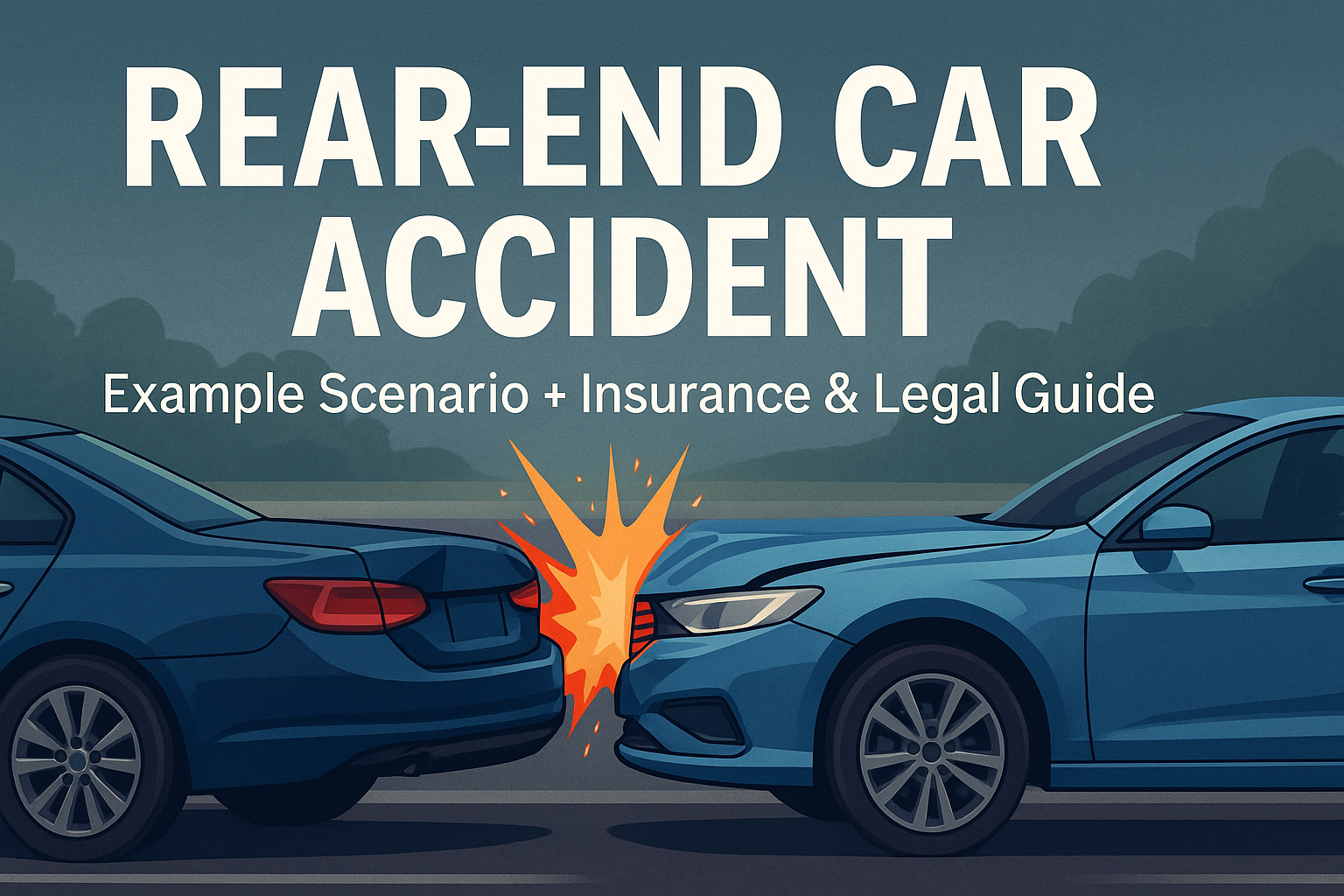Rear-end car accidents are among the most common motor-vehicle collisions in New York City.
In this guide, we break down a realistic rear-end crash scenario, explain how insurance works, and review your legal options after being hit from behind.
If you’ve recently experienced a rear-end car accident, this article will help you understand your rights and next steps.
📍 Example Rear-End Car Accident Scenario (NYC)
Date: June 12, 2024
Time: 5:45 PM
Location: West 34th Street & 9th Avenue — Manhattan, NY
During evening rush hour, a 2018 Honda Civic driven by Sarah Thompson stopped at a red light.
A 2020 Toyota Camry, driven by John Miller, failed to brake in time and struck the Honda from behind.
This is a textbook rear-end collision, where the trailing driver is generally presumed at fault.
🚘 Vehicle Damage
Vehicle 1 — Honda Civic (Front / Struck)
- Rear bumper crushed
- Trunk misalignment
- Possible sub-frame damage
Vehicle 2 — Toyota Camry (Rear / Striking)
- Front bumper damage
- Cracked headlight
- Hood damage
⚕️ Injuries Reported
The Honda driver reported:
- Neck pain
- Upper-back pain
- Headache
She was taken to Bellevue Hospital Center, where doctors suspected whiplash / soft-tissue injury.
The Toyota driver reported no injuries.
Whiplash is one of the most common injuries in rear-end collisions.
👮 Police Response & Witness
NYPD officers responded to the scene and confirmed:
- The Honda was fully stopped at a red light
- The Camry rear-ended it
A bus-stop witness confirmed the sequence.
Nearby security cameras appeared to capture the incident.
The Toyota driver was cited for unsafe operation / failure to stop.
⚠️ Who Is at Fault in a Rear-End Accident in New York?
Under New York traffic law, the rear driver is almost always presumed at fault.
Drivers must maintain a safe distance and pay attention to traffic conditions.
✅ In this scenario, the Toyota driver is clearly at fault.
This makes the liability portion of the insurance claim more straightforward.
🛡 How Insurance Works in New York (No-Fault)
New York is a no-fault insurance state.
This means:
➡️ Your own car insurance covers your medical bills, no matter who caused the crash.
After the accident, the Honda driver filed a no-fault claim.
If her injuries meet the serious injury threshold, she may also file a personal injury claim against the at-fault driver to seek compensation for:
- Pain & suffering
- Lost wages
- Long-term medical costs
- Vehicle damage
✅ Evidence Collected
- Photos of damage
- Witness statement
- Police accident report
- Security camera footage
- Hospital records
These materials can strongly support a claim.
📝 Scene Diagram (Not to Scale)
West 34th Street – Eastbound
==================================================================
| |
| Lane 1 Lane 2 Lane 3 |
| |
| [ V1 – HONDA ] ← Stopped at red |
| ┌──────────┐ |
| │ HONDA │ |
| └──────────┘ |
| ↑ |
| Impact Point |
| ↓ |
| ┌──────────┐ |
| │ TOYOTA │ [ V2 – Camry ] |
| └──────────┘ |
| |
==================================================================
9th Avenue (North–South)
↑
|
Bus Stop + Witness
|
↓
✅ What To Do After a Rear-End Crash in New York
- Move to safety
- Call 911
- Get medical attention
- Take photos & videos
- Collect witness details
- Request a police report
- Notify your insurance
- Consider speaking with an attorney
Even minor collisions can cause long-term injuries, so treatment is essential.
⚖️ Your Legal Rights
You may seek compensation for:
✅ Medical expenses
✅ Lost earnings
✅ Pain & suffering
✅ Property damage
✅ Ongoing medical care
If injuries are serious, you may pursue a lawsuit against the at-fault driver.
📌 Summary
- The Honda was stopped at a red light
- The Toyota struck it from behind → at-fault
- The Honda driver suffered whiplash-type injuries
- NY no-fault insurance covers medical bills
- Additional compensation may be available
Rear-end crashes happen fast, but knowing your rights and responsibilities can make a big difference.
FAQ
1) Who is usually at fault in a rear-end collision?
In most cases, the rear driver is presumed at fault because they are required to maintain a safe following distance. However, exceptions may exist in cases involving sudden or unsafe actions by the lead driver.
2) Do I need to call the police after a rear-end accident?
Yes. You should always report an accident to law enforcement. A police report provides critical documentation for insurance and potential legal claims.
3) What injuries are common after a rear-end car accident?
Whiplash, back pain, headaches, and nerve issues are common. Some symptoms appear days after the crash, so medical evaluation is important.
4) Does New York’s no-fault insurance cover my medical bills?
Yes. No-fault (PIP) generally covers medical treatment regardless of who is at fault, up to policy limits.
5) Can I sue the at-fault driver?
You may file a lawsuit if your injuries meet New York’s “serious injury threshold,” or if your expenses exceed no-fault limits.
6) How long do I have to file an accident claim?
For personal injury lawsuits, New York’s statute of limitations is typically 3 years. No-fault claims usually must be filed within 30 days, so prompt action is essential.
7) Should I talk to the other driver’s insurance company?
It’s generally best to speak cautiously — providing statements may harm your claim. Consider consulting a lawyer first.

